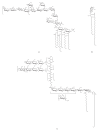The role of lipopeptidophosphoglycan in the immune response to Entamoeba histolytica
- PMID: 20145703
- PMCID: PMC2817369
- DOI: 10.1155/2010/254521
The role of lipopeptidophosphoglycan in the immune response to Entamoeba histolytica
Abstract
The sensing of Pathogen Associated Molecular Patterns (PAMPs) by innate immune receptors, such as Toll-like receptors (TLRs), is the first step in the inflammatory response to pathogens. Entamoeba histolytica, the etiological agent of amebiasis, has a surface molecule with the characteristics of a PAMP. This molecule, which was termed lipopeptidophosphoglycan (LPPG), is recognized through TLR2 and TLR4 and leads to the release of cytokines from human monocytes, macrophages, and dendritic cells; LPPG-activated dendritic cells have increased expression of costimulatory molecules. LPPG activates NKT cells in a CD1d-dependent manner, and this interaction limits amebic liver abscess development. LPPG also induces antibody production, and anti-LPPG antibodies prevent disease development in animal models of amebiasis. Because LPPG is recognized by both the innate and the adaptive immune system (it is a "Pamptigen"), it may be a good candidate to develop a vaccine against E. histolytica infection and an effective adjuvant.
Figures


Similar articles
-
The innate immune response to Entamoeba histolytica lipopeptidophosphoglycan is mediated by toll-like receptors 2 and 4.Parasite Immunol. 2005 Apr;27(4):127-37. doi: 10.1111/j.1365-3024.2005.00754.x. Parasite Immunol. 2005. PMID: 15910421
-
Natural killer T cells activated by a lipopeptidophosphoglycan from Entamoeba histolytica are critically important to control amebic liver abscess.PLoS Pathog. 2009 May;5(5):e1000434. doi: 10.1371/journal.ppat.1000434. Epub 2009 May 15. PLoS Pathog. 2009. PMID: 19436711 Free PMC article.
-
Lipopopeptidephosphoglycan from Entamoeba histolytica activates human macrophages and dendritic cells and reaches their late endosomes.Parasite Immunol. 2007 Sep;29(9):467-74. doi: 10.1111/j.1365-3024.2007.00963.x. Parasite Immunol. 2007. PMID: 17727570
-
Host-pathogen interaction in amebiasis and progress in vaccine development.Eur J Clin Microbiol Infect Dis. 1998 Sep;17(9):601-14. doi: 10.1007/BF01708342. Eur J Clin Microbiol Infect Dis. 1998. PMID: 9832261 Review.
-
Progress towards development of a vaccine for amebiasis.Clin Microbiol Rev. 1997 Oct;10(4):637-49. doi: 10.1128/CMR.10.4.637. Clin Microbiol Rev. 1997. PMID: 9336666 Free PMC article. Review.
Cited by
-
Comparison of methods for detection of Blastocystis infection in routinely submitted stool samples, and also in IBS/IBD Patients in Ankara, Turkey.PLoS One. 2010 Nov 18;5(11):e15484. doi: 10.1371/journal.pone.0015484. PLoS One. 2010. PMID: 21124983 Free PMC article.
-
Apocynin, an NADPH Oxidase Enzyme Inhibitor, Prevents Amebic Liver Abscess in Hamster.Biomedicines. 2023 Aug 21;11(8):2322. doi: 10.3390/biomedicines11082322. Biomedicines. 2023. PMID: 37626818 Free PMC article.
-
The Role of TLR2 in Infection and Immunity.Front Immunol. 2012 Apr 18;3:79. doi: 10.3389/fimmu.2012.00079. eCollection 2012. Front Immunol. 2012. PMID: 22566960 Free PMC article.
-
Malaria and an Amoebic Abscess in a Returning Traveler from Liberia.Case Rep Infect Dis. 2023 Jul 20;2023:1466397. doi: 10.1155/2023/1466397. eCollection 2023. Case Rep Infect Dis. 2023. PMID: 37521242 Free PMC article.
-
"Immunoinformatic Identification of T-Cell and B-Cell Epitopes From Giardia lamblia Immunogenic Proteins as Candidates to Develop Peptide-Based Vaccines Against Giardiasis".Front Cell Infect Microbiol. 2021 Oct 27;11:769446. doi: 10.3389/fcimb.2021.769446. eCollection 2021. Front Cell Infect Microbiol. 2021. PMID: 34778111 Free PMC article.
References
-
- Araujo J, García ME, Diaz-Suárez O, Urdaneta H. Amebiasis: importance of the diagnosis and treatment. Minireview. Investigación Clínica. 2008;49(2):265–271. - PubMed
-
- Nari GA, Ceballos ER, Carrera Ladrón G, et al. Amebic liver abscess. Three years experience. Revista Española de Enfermedades Digestivas. 2008;100(5):268–272. - PubMed
-
- Graillet R, Sánchez Aguilar M, Morán-Mendoza AO, Hernández-Sierra JF, Gordillo-Moscoso A, Tapia-Pérez JH. Analysis of factors associated to failure of medical treatment of amoebic liver abscess. Cirugía Española. 2008;84(2):83–86. - PubMed
-
- Pritt BS, Clark GC. Amebiasis. Mayo Clinic Proceedings. 2008;83(10):1154–1160. - PubMed
Publication types
MeSH terms
Substances
LinkOut - more resources
Full Text Sources
